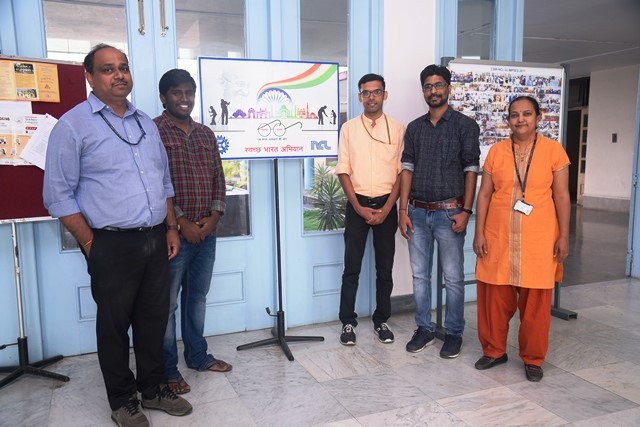"Dream, Dream, Dream! Conduct these dreams into thoughts, and then transform them into action."
- Dr. A. P. J. Abdul Kalam
"Dream, Dream, Dream! Conduct these dreams into thoughts, and then transform them into action."
- Dr. A. P. J. Abdul Kalam
28 Feb 2024
Hazardous trash produced by hospitals and other medical facilities is known as (Plaster Of Paris) POP waste. In dentistry, it is mostly used to make casts and to fix fractured or broken bones. The garbage must be disinfected since it is contaminated with germs. It has an impact on those who gather, sort, and dispose of it in addition to the environment.
The Institute of Chemical Technology's Jalna campus in Mumbai and the National Chemical Laboratory (CSIR-NCL) in Pune has developed a new method tthat treats such waste without doing any harm. Waste is disinfected and transformed into beneficial goods like calcium bicarbonate and ammonium sulfate. It can be utilized as a greener substitute for the incineration procedure that is now in use. The method can also be applied to break down PoP waste from idols submerged in water.
This new technique involves treatment with an ammonium bicarbonate (ABC) solution with a concentration of 20 percent. The solution was found to disintegrate the waste into high-value and non-toxic chemicals such as ammonium sulfate and calcium bicarbonate in the form of sludge in 24 hours to 36 hours at room temperature. Ammonium sulfate can be utilized as nitrogen fertilizer, fire-extinguishing powder, and in industries like pharmaceutical, textile, and wood pulp. Calcium carbonate can be used in the metallurgy industry, mainly in steel manufacturing.


How It's Impacting ~
There have been efforts to ban the sale of plaster of Paris (PoP) idols for the Ganesh Chaturthi festival in the past, but these have proved futile. The biggest hurdle in implementing such a ban is the fact that there is no definitive and comprehensive scientific study on the impact of PoP on the environment. Studies on the impact of idol immersions carried out in places like Bhopal, Jabalpur, and Bengaluru show several significant impacts like a steep rise in the concentration of heavy metals, dissolved solids, and acid content, and a drop in dissolved oxygen.
Since these studies mostly center around testing of water quality before and after immersions, the results reflect the cumulative effect of PoP, clay, chemical colors, and other materials; there is no way to ascertain the exact role of PoP in water pollution as well as its larger impact on the environment.

Hospital garbage is usually collected and burned by municipal waste collectors. Pollution of the air and soil is caused by incinerating waste because it releases heavy metals and hazardous gasses. Additionally, the ammonium bicarbonate 20% solution has antibacterial and antifungal properties. It could eradicate 99.9% of the microorganisms found in POP trash samples in three hours. In particular, the solution breaks down bio-films developed on plaster in orthopedic wastes. Dr. Mahesh Dharne, the team leader, stated that this approach might be useful in rural and isolated places with no facilities for disposing of biological waste. It was also discovered that the method worked well for breaking apart plaster-of-Paris idols. The Pune Municipal Corporation is interested in utilizing it to address the pollution issue.
In the Future~ why do water bodies need our help more than ever?
India has an abundance of historically significant waterbodies that are geographically distributed throughout the nation. These water bodies are referred to by many names, including ponds, tanks, lakes, amalgam, lahars, bawdiness, tabs, and others. They are crucial to preserving and reestablishing the ecological equilibrium. They sustain biodiversity, serve as sources of drinking water, replenish groundwater, regulate flooding, and give a lot of people jobs.
India is now experiencing a severe water crisis, with several major cities experiencing a severe water deficit and 100 million people living on the country's front lines. The situation is expected to deteriorate further, as forecasts from the United Nations and Niti Ayog indicate that by 2030, 40% of India's population will lack access to safe drinking water, with water demand expected to surpass availability. Our growing carelessness and disregard for protecting water bodies is one of the causes.The government has assumed control over the management of water bodies and water supplies since independence. However, adopting a colonial mindset, authorities prioritize network expansion, infrastructure development, and dam construction, often neglecting local needs and favoring distant water sources.
How Can We Contribute?
Increasing population, rising standards of living, and rapid growth of industry and urbanization are stressing water resources particularly our rivers which are getting polluted. Rivers are our lifelines and an integral part of our civilization. Many Indian rivers, including the Ganga over several stretches have become unfit even for bathing during the lean season. River catchments and banks should have plantations and should have a minimum flow even during the lean season. The practice of dumping of wastes in the river has to cease for the health of the river.
Tips ~
Overall, we must see water shortage as a serious issue since it is extremely harmful. Furthermore, once identified, we must take action to preserve it. We can accomplish a lot of things at both the national and individual levels. So, we must band together today to preserve water.